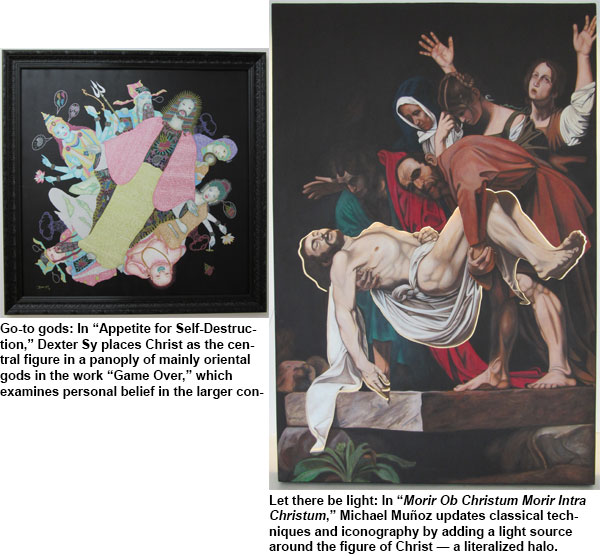Jesus Christ, art superstar

Something happened in three simultaneous shows recently. In Felix Bacolor’s “Sick and Tired of Being Sick and Tired” (Art Informal), Michael Muñoz’s “Oculos Fidei” (Blanc), and Dexter Sy’s “Appetite for Self-Destruction” (1335 Mabini), Jesus Christ featured prominently as subject. One would surmise that the artists were fully aware of the implications of tapping into such a welter of visual resource, which would generally be endowed with an extra degree of attention by the viewer, given how central Christianity is in the life of the country. In any work bearing a trace of the Crucifix, Mother Mary, or say the Holy Spirit as a dove, iconography as content would take precedence over formal strategies. As viewers, we ask questions we don’t normally accord to any work of art, such as, “How does it address and/or interrogate my sense of piety?”
The exhibitions mentioned, however, won’t generate the furor of, say, Mideo Cruz’s “Poleteismo” with its radical, sit-up-straight blasphemies in its juxtaposition of religious symbols and pop and sexual imagery — the putative staging ground of the sacred and the profane. The image of Christ in these works was not in any way defaced or hostaged from its aura of divinity. While Bacolor’s version of Christ was shown in the contemporary setting of a hospital, his face sad and pleading from a metal bed, it still very much upheld the virtue and power of the suffering of Jesus, which the artist used as a focusing lens to examine modern malaise and anxiety. Sy, on the other hand, made Christ as the central figure in a panoply of mainly oriental gods in the work “Game Over,” which was an examination of belief in the context of race, identity and history.

Muñoz, however, told a different story. While it seems inevitable that the use of sacred imagery in contemporary art can only be in the service of irony (or, in the case of Cruz, hyperbole), the CCP 13 Artists awardee took a more heartfelt tack by approximating Christ in His Renaissance glory, the Word made flesh. In “Morir Ob Christum Morir Intra Christum,” for instance, Christ is shown as freshly removed from the cross and is about to be entered into a tomb. His pale, lifeless body cuts horizontally across the canvas, a cradle of cloth billowing beneath him. A cycle of hands visually shows his journey from the divine to the mortal and back, beginning with Christ’s arm pointing towards the earth, continued by Mary’s open palm in a gesture of resolute acceptance, and then picked up heavenward by the upraised, grief-stricken arms by, presumably, Magdalene.
What makes this work not merely a paean or a throwback to classical techniques is the subtle flushing out of the image of Christ from the picture plane, with the gap filled with the glow from an actual light source. It is a literalized halo. This conceit is repeated in “Emmaus,” where the figure of Christ is taken out of the canvas, leaving just an outline, and is replaced with a white cloth, literally a mantle, which signifies His spiritual authority. Essentially mixed media, these works make palpable the key elements in sacred art, rendering age-old iconography with the hint of the now.
“Oculos Fidei” is but a continuing foray in the artist’s exploration and creation of devotional art, starting with “Deus Historiae” at West Gallery in 2010 and “Christiadum” at Blanc Peninsula in 2012. Some of the works in “Oculos Fidei” have actually been exhibited in previous shows, which may point out the dearth of collectors for his kind of work. Religious imagery in “fine art” is not trendy — unless it is subverted. No matter. Muñoz, whose works can be right at home in a domestic chapel or a small church, exhibits a religious conviction rare in these times, recasting Catholic symbols as fresh points of contemplation. While it is ridiculous to assume that any spiritual conversion can be had by simply viewing these works, they ritualize our faith in the act of looking, affirm our pieties, and refine our appreciation for the scale, balance, and composition of a religious culture we seem ready to defend at a moment’s notice.


















